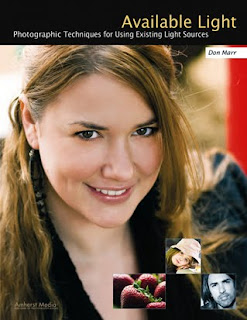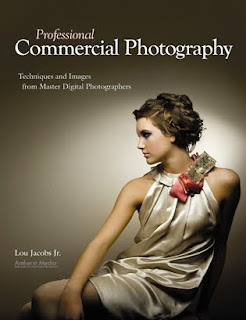 Today's post comes from the book Mother and Child Portraits: Techniques for Professional Digital Portraits by Norman Phillips. It is available from Amazon.com and other fine retailers.
Today's post comes from the book Mother and Child Portraits: Techniques for Professional Digital Portraits by Norman Phillips. It is available from Amazon.com and other fine retailers.When posing children under one year of age, we must consider comfort and safety more than is required with any other group. In this chapter, we will see a variety of excellent posing options that will help you meet these important objectives when photographing your own subjects.
In the first image (photo by Sarah Johnston), the closeness of the subjects depicts the special relationship they share. The fact that the baby’s hand is beautifully placed on the mother’s shoulder makes the posing that much more special. Add this to the three-quarter view of the mom, and we have a delightful portrait.
 The baby appears wrapped in a soft, white blanket. The fabric adds texture in the image and nicely sets off the infant’s skin tones. Because the blanket was white, it supported the high-key concept of the image. It is these little things that make the difference. The high-key vignette makes this black & white impression very appealing. See the diagram below.
The baby appears wrapped in a soft, white blanket. The fabric adds texture in the image and nicely sets off the infant’s skin tones. Because the blanket was white, it supported the high-key concept of the image. It is these little things that make the difference. The high-key vignette makes this black & white impression very appealing. See the diagram below.
Next (photo by Jody Coss) is a high-impact image that employs the split lighting technique to perfection. Most interesting is that it holds our attention even though we cannot see the baby’s face or the mom’s eyes. The contrast is much greater than we would normally expect to see in this type of portrait.

To create this image, Jody used a small softbox, positioned with the bottom edge at the mother’s chin and tilted downward. The front edge of the light was positioned level with the baby’s head. Reflected light from the right of the camera gently separated the subjects from the background.
Note the delicate diagonal line that runs through the mother’s hand and up toward her brightly lit hair. This is the result of carefully considered posing of the two subjects. Jody digitally created a black mat for the image and added a lovely sentiment to enhance the portrait. It is an excellent example of the steps that can be taken to increase the impact of your images.
The next sequence of images (photos by Norman Phillips) illustrates how we can use window light in portraiture. In the first, the mother and her baby are posed almost in the window frame so that the bright white wall creates a split lighting set and virtually blows out the highlights on her left cheek. The pose allowed the mom and her baby to respond to the camera.

Here, the baby turned her head toward camera left. The change in position caused the light ratio on her face to be reduced. This is better for the baby, but it does not improve the lighting on the mother.

To create the image shown in the next photo, I moved the subjects away from the window to reduce the contrast and more evenly illuminate them. This eliminated the bright white wall near the window and made for a more acceptable set. There is a 21/2:1 light ratio in the portrait.

In this photo, the subjects were moved farther into the room, and the result was more even lighting. We now have a 2:1 ratio.

For the last photo, the subjects were moved once more. The mother was positioned on the bright side of the set, and the subjects’ angle to the light was more oblique. This caused the light to be feathered across the subjects. With the change in position and the mom’s head partially blocking the light from falling on the baby’s face, we achieved the desired 3:1 light ratio.

The posing in these portraits is conventional, with the mother and infant cheek to cheek but with the baby’s head at a lower position in the composition, thereby creating a diagonal line between the subjects.
This photo (by Jeff and Kathleen Hawkins) shows a profile pose of the mother and her naked baby. When we present this pose, we demonstrate the relative size of the baby because the mother’s hands are cradling her. Having the baby lifted close to the mom’s head further emphasizes her small size.

A softbox was placed at 30 degrees off the subjects, with another softbox illuminating the back of the mother’s head. This produced a relatively even lighting pattern with a ratio of a little over 2:1. By placing the subjects against a low-key backdrop, Jeff and Kathleen produced a dramatic contrast between the subjects and the background. The impact is strong yet soft and flatters both subjects. The diagram for this photo is below.

Mark Laurie is well known for his glamour style portraiture—a subgenre in which female subjects are typically less than fully clothed. In this photo, the mom appears without any evidence of clothing. The image emphasizes the physical contact that is so crucial in the nurturing of an infant. The portrait is simply delightful. It shows the happiness that the two share, even if the baby is unable to express it at such an early age. It is the impression that we should seek to create when photographing a mom and her infant.

Mark used a large 40x60-inch softbox at 45 degrees from the camera and subjects (at camera right) in a brightly lit set, where the ambient light provided fill. The overall lighting produced a beautiful rendering of the subjects’ skin tones.
The photo below is another Mark Laurie portrait that depicts the natural, nurturing bond between a mother and her baby. It is beautifully feminine and evokes the tenderness associated with motherhood.

A 40x60-inch softbox was placed at camera right, and a large reflector at the left of the subjects provided a fill source equal to 1/2 f-stop less than the main light. The overall lighting cast an even illumination across both figures and beautifully rendered the skin tones. The pose shown here is natural and needed only a little refinement from Mark to ensure the subjects’ best-possible presentation to the camera.
BUY THIS BOOK FROM AMAZON


















